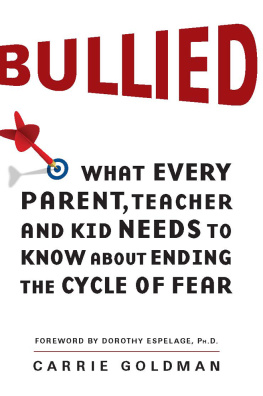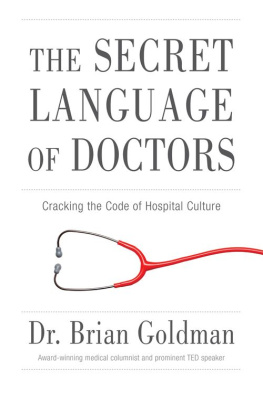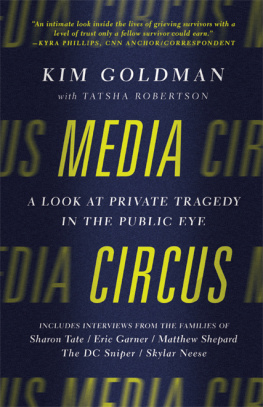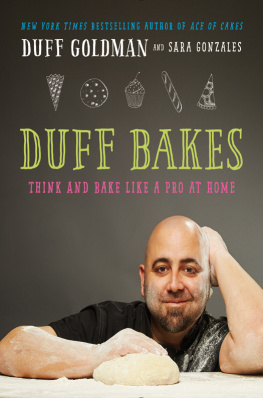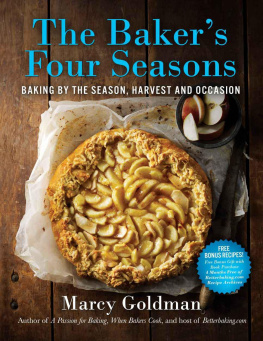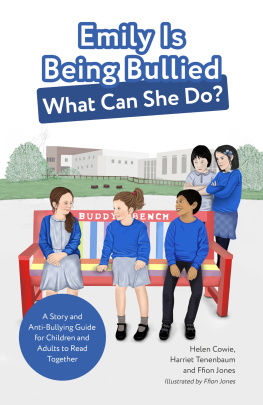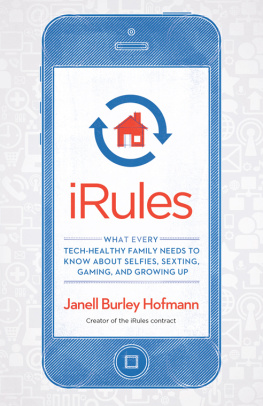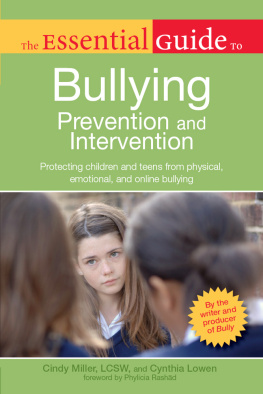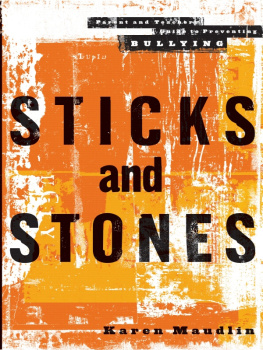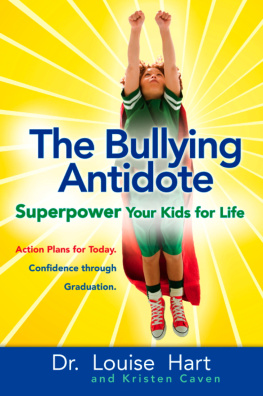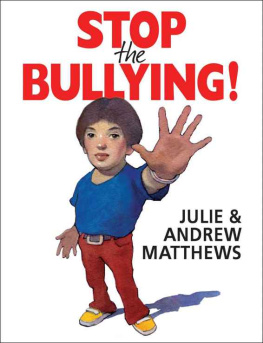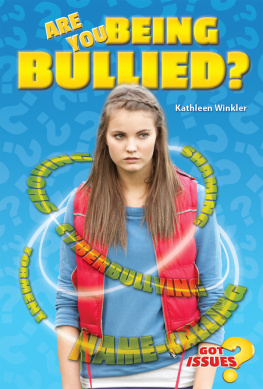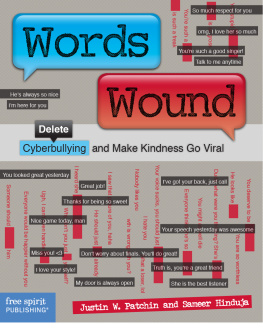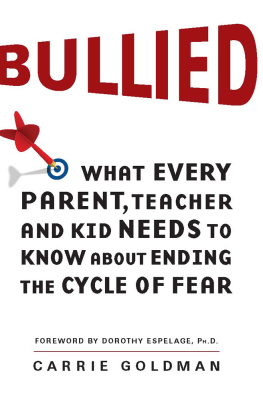
BULLIED
What Every Parent, Teacher, and Kid Needs to Know About Ending the Cycle of Fear
Carrie Goldman

The names of all victims, bullies, parents, and bystanders who have participated in this book have been changed in order to protect their privacy, unless an interviewee specifically requested that I use his or her real name. The names of all children in Katies school, with the exception of Katie, have been changed.
The real names of those who wrote public comments on my blog are used where relevant.
The real names of all professionals who spoke to me in their professional capacitysuch as authors, psychologists, teachers, lobbyists, scientists, researchers, school administrators, actors, actresses, musicians, martial arts experts, etc.have been used in the book.
The real names of deceased bullycide victims are used in this book.
T HIS BOOK IS FOR MY HUSBAND , A NDREW ,
WHO IS MY PARTNER IN EVERYTHING .
Contents
Professor Dorothy L. Espelage, Ph.D.
University of Illinois, Urbana-Champaign
After almost twenty years of conducting research on bullying and trying to inform bully-prevention efforts in U.S. schools, why do I find myself so disappointed in the progress that we have made in creating safe schools and preventing suicide ideation and suicide attempts among schoolchildren? Why do kids continue to bully each other on such a regular basis? Why, if our government tells us that we have proven school-based bully-prevention programs, are we not moving down the needle of bullying in schools and reducing the likelihood of bully involvement among children and adolescents?
Although I could offer many reasons why bullying in our schools is not reduced, one that is particularly obvious to me is a lack of communication and collaboration among researchers, practitioners (including teachers and administrators), and parents. All too often, scholars conduct their research studies and disseminate their findings to other scholars and rarely attempt to translate their findings into practical solutions for schools. Thus, this academic isolation or elitism leaves the practitioners questioning the commitment of researchers to impart real-world solutions to prevent bullying. On the other hand, numerous books and curriculum are developed by former teachers, concerned parents, and other concerned community members with little attention paid to the decades of developmental, social, and educational scholarship on the topic of peer victimization, aggression, and bullying. As a result, the science-to-practice divides have widened to the greatest we have seen in decades.
Is it a surprise that bullying is not going away? Well, this book, Bullied, by Carrie Goldman offers me a sigh of relief. When Carrie first reached out to me to share her daughters story and her book idea, I was intrigued. I found myself saying, Okay, you want to talk to everyone that you can about bullying, including scholars, parents, pop-psych authors, and so forth? I was thrilled. I have to also admit that I was wondering if she could pull it off. She has done just that.
She offers a book in which researchpracticeand lived experiences inform each other. For the first time, I see where psychological and sociological theories of aggression and bullying help explain all of the complicated aspects of Katies story and stories that ring through the halls of U.S. schools. Carrie places Katies story into the complex gendered world that we live in and demonstrates the importance of understanding bullying as a gendered problem and one that requires a gendered solution. Katies story would not have happened if bullying and peer victimization were not understood as peer-driven phenomena where kids encourage disrespectful and mean interactions, where ostracism and humiliation is the ultimate goal.
In Bullied, Carrie enlightens us about the instrumental role that adults play in allowing bullying and peer victimization to continue, from homes to school yards to community centers. From this book, it is clear that adults need to spend much more time evaluating their own attitudes and behaviors and how bully prevention rests with everyone in society.
In short, Bullied demonstrates how science and practice can work together to prevent bullying. Carrie Goldman has taken the best of what scholars know about the development of bullying in children and has offered a number of insights about how individuals, peers, schools, families, and community members all contribute to this extremely devastating phenomenon and how we all have to work together to decrease it. Her writing style and storytelling leave the reader appreciating the importance of using research to identify real-world solutions to bullying but also understanding that research can be improved by understanding the lived experiences of children and their families. She should be applauded for taking the risk to write about Katies story and doing it in a way that narrows the research-practice gap. Thank you, Carrie, for inspiring me to continue to prevent bullying!
In November 2010, I wrote a post called Anti-Bullying Starts in the First Grade for my blog, Portrait of an Adoption . I was concerned because my daughter, Katie, was upset about being teased for carrying a Star Wars water bottle. Apparently, Star Wars was only for boys.
It was the post that launched a thousand Geeks. Comments poured in so fast that they crashed the entire ChicagoNow server. Katies story appeared on international and national news shows. Radio talk shows had a field day with the story, and hundreds of bloggers wrote posts about the Star Wars teasing. A Facebook event was created in support of Geek Pride and Katie, and over thirty-five thousand people participated. Feminists, Star Wars fans, adoptees, adoptive parents, former victims of teasing and bullyingall jumped to a young fangirls defense.
Why did the article strike such a responsive chord? Because in a time of heartbreaking headlines about cyberbullying, my child experienced a refreshing new phenomenona term I am calling cybersupporting. People were hungry for a bullying case that offered hope of a happy ending, and Katies situation became a Cinderella story. It was then that I embarked on a journey to research bullying in our culture.
Bullying has emerged as one of the biggest problems facing our nations schools to date, but this is largely due to increased awareness and sensitivity about the consequences of being victimized. The media has created a sense of urgency around bullying, and parents are desperate to protect their children. We are closely tracking bullying and taking steps to reduce aggressive acts. We are counting the victims. A 2010 study by the National Center for Education Statistics found that 32 percent of students between the ages of twelve and eighteen reported being bullied within the six months prior to being surveyed. Of the students surveyed, 62 percent reported having been bullied once or twice a year, 21 percent once or twice a month, 10 percent once or twice a week, and 7 percent reported being bullied every day . The 2009 National Youth Risk Behavior Survey found that about one in five teens had been bullied at school in the last year, with nearly half of middle-school students being bullied.
Although far too many kids are victimized, the hopeful news for parents and educators is that some measures of bullying have actually dropped since 1999. Ron Astor, coauthor of the critically acclaimed book School Violence in Context: Culture, Neighborhood, Family, School, and Gender, told me, Starting in 1994, many school violence measures began to drop and have continued to drop. But just because our research shows things have gotten better doesnt mean its not still a very serious problem. And the subjective category of bullying has gone up. Yes, 15 percent is clearly the minority, and it is important to keep that in perspective, but in terms of sheer numbers, it still represents millions of traumatized children. For those children who do encounter significant, severe bullying, the damage is lasting and the implications for a normal social life are devastating.
Next page
